There was the New Newark. And then the New New Newark. But now, as development ramps up in and around the city’s Ironbound section, one of New Jersey’s largest cities may finally, permanently, escape the need for another rebranding effort.
Long known for its tidy streets and Portuguese and Brazilian restaurants, the Ironbound district is attracting more retail and office development than ever, sources said. “It’s no longer the best-kept secret in Newark,” said Lenny Lazzarino, vice president of leasing at Edison Properties.
The neighborhood’s steady growth has largely been spurred by the multiphase Riverfront Park development, which covers miles of remediated parkland along the Passaic River and already features soccer fields, running paths and boat tours.
The planning and development of the sprawling project’s Phase C — in which developers plan to add more lighting, an outdoor gym and gaming tables along an interim path from Freeman to Fillmore Streets — began in the middle of 2018 and is expected to continue for the next five years. The park is being expanded from Madison Street to 4th Avenue, with the design work being done by James Corner Field Operations, designer of the High Line in New York City.
“To have that park and whole waterfront redeveloped and have that park and the Ironbound linearly connected to the rest of the city is a big deal for the city,” said Vince Baglivo, director of communications for the Ironbound Business Improvement District.
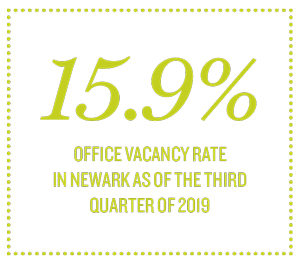 Interest in the Ironbound section is also picking up due to the reinstatement of MX-3, mixed-use residential and commercial zoning for some of the land in the district by Newark Penn Station, near where Blue Cross Blue Shield is located, Baglivo said. MX-3 went into effect in early 2019, allowing the construction of buildings up to 11 stories tall.
Interest in the Ironbound section is also picking up due to the reinstatement of MX-3, mixed-use residential and commercial zoning for some of the land in the district by Newark Penn Station, near where Blue Cross Blue Shield is located, Baglivo said. MX-3 went into effect in early 2019, allowing the construction of buildings up to 11 stories tall.
Nearby to the north, demolition is underway to clear Riverfront Stadium, home of the now-defunct Newark Bears minor league baseball team. The property sold for $23.5 million in 2016 to Lotus Equity Group. Lotus was founded by Ben Korman, who also owns C&K Properties, which sold off 1, 2 and 4 Gateway Center to a group of investors lead by Onyx Equities (read more about the trade on page 48). The new owners of Gateway Center are planning a massive revamp of the office and retail spaces there.
But over on the former stadium’s property and the site of the former Lincoln Hotel next door, Lotus Equity Group will be building Riverfront Square, a 12-acre, 4.8 million-square-foot development. It is approved for up to 2 million rentable square feet of office space, as well as more than 2,000 apartments, a hotel and 130,000 square feet of retail space and amenities. Architect Vishaan Chakrabarti of Practice for Architecture & Urbanism designed the space.
“The Riverfront Square development will be transformational for the city of Newark and will have a very positive effect activating the streetscapes and connecting all the wards of the city, including the Ironbound district, spurring renewed interest in residential and expanded retail offerings,” said John Picco, executive director of global brokerage for Cushman & Wakefield.
Construction of the first commercial building, a 500,000-square-foot mass timber project, will start in the spring, along with a 2,000-car parking garage, Picco said. Designed by Michael Green Architecture, the cross-laminated wood building will be the first of its kind on the East Coast and the largest in the U.S., according to Picco.
“We’re looking for a good anchor tenant to start off the office building, which we’d like to do simultaneous with the first residential building,” Picco said. The project’s highest point, the office tower, will be 12 stories tall.
Port of opportunity
The industrial area about two miles east of Ironbound, next to Routes 1 and 9, is also attracting new development. The Port of New York and New Jersey is running out of leasable space, with shippers renting warehouse space as far away as the Meadowlands. Newark, as home to one of the six marine terminals at the port, is preparing to take ownership of land near and along Doremus Avenue, on the north side of the port, using the power of eminent domain, according to the trade publication JOC.

In one sign of the action on Doremus, Kuiken Brothers Company, a 107-year-old firm, held the grand opening of a full-service residential and commercial materials building yard at 500 Doremus, on a 10-acre site up the road from Port Newark, on Oct. 10.
“We really wanted to have a footprint closer to this market that is inside of this market,” said Matt Kuiken, vice president of operations. “We have access to all of the major highways that come through this area and have a really active rail spur that comes onto this site. People are recognizing Doremus Avenue has a lot of benefit. It has deep-water access and good, reliable rail service.”
Rents rise in Ironbound
Amidst all of the development, office rents in the Ironbound neighborhood have risen as vacancies have gone down, according to Rich Gatto, a senior associate at Marcus & Millichap who focuses on multifamily and mixed-use properties in Essex and Union counties. He estimated that the rate for the neighborhood ranges in the mid- to high $20s per square foot.
The vacancy rate for office space in Newark in Q3 was 15.9 percent, according to a market report by Cushman & Wakefield.
Retail leases vary considerably by location, with shops on Broad and Market streets having the highest rents, Gatto said. Rents at those locales are in the $40-per-square-foot range, compared to rents of $18-20 per square foot and sometimes less on the side streets, he said.
Downtown and the Ironbound are the trendiest spots in Newark, with more of the “hipster vibe” in Downtown, said Gatto. University Heights is shaping up to be the city’s next hot neighborhood, with more hip, younger residents than the rest of the city, he said.
Here is a look at some of the new development that is taking place in and adjacent to the Ironbound district.
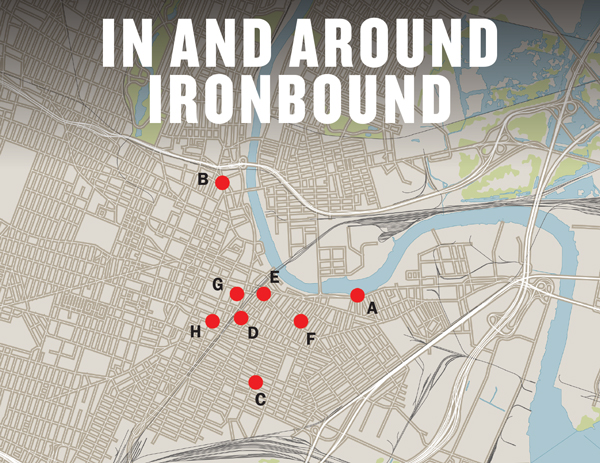 A) Riverfront Park multiphase development
A) Riverfront Park multiphase development
This development of park space along the Passaic River is expected to bring mixed-income housing, retail and a mix of office space to the Ironbound over a span of five years. Once the project is done, Riverfront Park will span two miles, extending from Brill Street on the eastern end to Bridge Street on the northwestern side. “This is going to be catalytic,” said Bernel Hall, president and CEO at Invest Newark, an economic development corporation. “It will spark the transformation of everything adjacent for probably four blocks out.”
B) Riverfront Square
450 Broad Street
This mixed-use development on 12 acres of Opportunity Zone space “complements the future Riverfront Park,” Lotus Equity Group CEO Ben Korman said in an announcement about the project. Lotus expects to build up to 2,000 residential units, 2 million square feet of office space, and parking on the parcel at the heart of Newark’s Broad Street corridor.
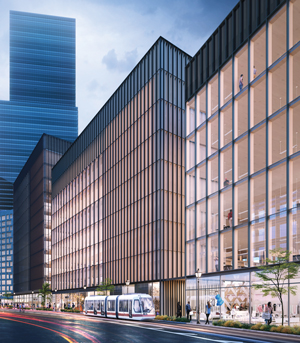
Riverfront Square
C) Two River Community Bank
260 Chestnut Street
In June, the bank opened its first full-service branch in Essex County in the Ironbound district. The bank made an unspecified donation to the 50-year-old Ironbound Community Corporation, which provides family services such as preschool. Two River Community Bank, which is merging with OceanFirst Financial Corporation, could not comment due to the pending merger.
D) 3rd Space
142 Lafayette Street
Touting itself as the “first boutique luxury co-working space in the heart of Newark,” this new, 12,000-square-foot hub developed by J&L Companies at 142 Lafayette Street, next to Newark Penn Station and down the street from Spanish Tavern, offers workspaces, three conference rooms, a cafe, an event space that’s been attracting book signings and corporate events, and a podcasting studio. The co-working facility, which opened in May and had its grand opening in November, is now 80 percent occupied, with tenants from New York City drawn by the rents, according to Kenneth Miles, a founding partner. Options range from the $25 day pass to a private office for one to four people for $1,685 a month. “It’s a nice space that provides a service and opportunity for entrepreneurs,” said Joseph Della Fave, executive director of the Ironbound Community Corporation.
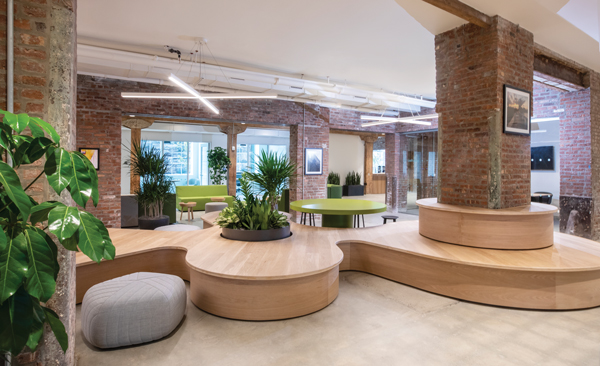
3rd Space
E) Blink Fitness
2-14 Ferry Street
The regional fitness chain opened its 69th location in a former bank building at 2-14 Ferry Street at Ironbound Plaza in April 2018, in partnership with commercial developer Paramount Assets.
F) Pestana Hotel
11-126 Monroe Street
This six-story, 109-room boutique hotel in the Ironbound district will break ground in late February or March 2020, according to Pedro Belo, a partner in SB Development, the developer. The 300-square-foot rooms at the 75,000-square-foot property are expected to go for about $140 a night when the hotel opens in June 2021, Belo said.
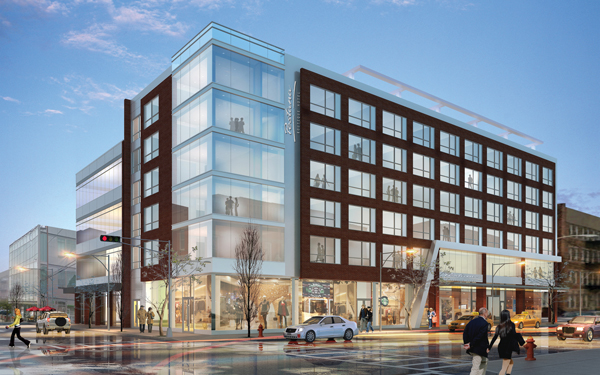
Pestana Ironbound Hotel
G) Ironside Newark
110 Edison Place
On the edge of the Ironbound, this business hub, developed by Edison Properties and designed by Perkins Eastman, has turned a once-vacant warehouse into more than 450,000 square feet of retail and loft-style workspaces at Edison Place and McCarter Highway. “It unifies with Ironbound for folks who go to the Prudential Center,” said Lazzarino, whose firm is headquartered in the building. Other tenants will include Mars Wrigley Confectionery, which will move into the building in early 2020, according to Lazzarino.
Office leasing rates are in the “upper $30s,” said Lazzarino, adding that retail deals are starting to close in the low to mid-$30s. The tenants include a coffee company and a fast casual restaurant that sells salad and protein bowls, and there’s space for a 12,000-square foot restaurant as well.
H) Mulberry Commons
317 Mulberry St.
The city of Newark is moving ahead on the $10 million development of 22 acres of vacant Downtown property into a park that will connect the Ironbound section with Newark Penn Station and the Prudential Center.
“It’s open — people are using it all the time, but it’s not completed,” said Baglivo. Ironside Newark directly faces Mulberry Commons. “We anticipate redevelopment will fill the areas around there on both sides of the highway,” Baglivo said. “People will want to live close to where they work, as well as have services. That’s the key—tying things together between Downtown and the Ironbound.”
